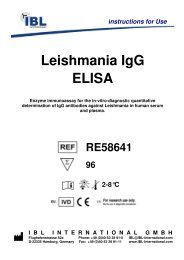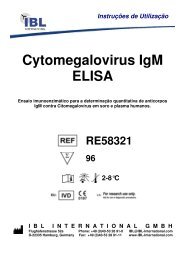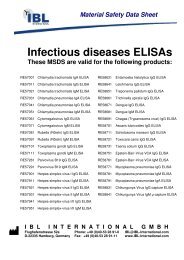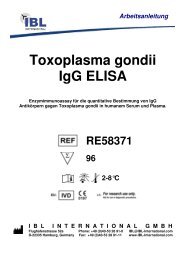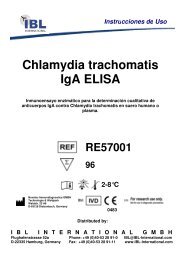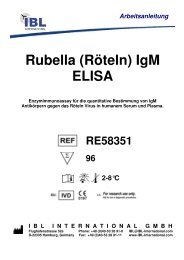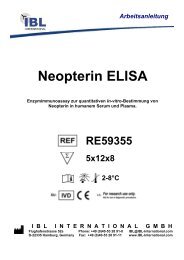CCP Ab ELISA - IBL international
CCP Ab ELISA - IBL international
CCP Ab ELISA - IBL international
Create successful ePaper yourself
Turn your PDF publications into a flip-book with our unique Google optimized e-Paper software.
<strong>CCP</strong> <strong>Ab</strong> <strong>ELISA</strong><br />
ENGLISH<br />
1. INTENDED USE<br />
The Anti-<strong>CCP</strong> test kit is an enzyme-linked immunosorbent assay (<strong>ELISA</strong>) for detection and semiquantitation<br />
of IgG antibodies to Cyclic Citrullinated Peptides (<strong>CCP</strong>) in human sera. The assay is<br />
used to detect antibodies in a single serum specimen. The results of the assay are to be used as an<br />
aid to the diagnosis of Rheumatoid Arthritis (RA), in conjunction with other laboratory and clinical<br />
findings. The analysis should be performed by trained laboratory professionals. “For in vitro<br />
diagnostic use”.<br />
2. SUMMARY AND EXPLANATION<br />
Rheumatoid Arthritis (RA) is one of the most common systemic autoimmune diseases. The aetiology<br />
of the disease, which affects up to 1-2% of the world population, is unknown. The diagnosis of RA<br />
depends primarily on clinical manifestation of the disease. The only serological test routinely used is<br />
the determination of the presence of rheumatoid factors (RF) in the serum. RF are antibodies directed<br />
to the constant region of immunoglobulins of the IgG class. However, these antibodies are also<br />
present in relatively high percentages in other autoimmune diseases, infections and in up to 15% of<br />
healthy individuals.<br />
Antibodies of a more specific nature have also been found in sera of RA patients (see (1) for an<br />
overview). Anti-perinuclear factor (APF) antibodies are reported to be present in around 50% of RA<br />
patients with a specificity of over 70% (2). A number of cyclic synthetic peptides not related to<br />
filaggrin or other known proteins were described which are specifically recognized by autoantibodies<br />
in sera from RA patients (3). These peptides were subsequently used in an EIA for the detection of<br />
RA-specific autoantibodies (3). Clinical evaluation studies showed that the EIA was positive in a<br />
significant number of well-defined RA patient sera with an excellent specificity against disease<br />
controls (3-8). A diagnostic and prognostic value for the measurement of the anti Cyclic Citrullinated<br />
Peptides (anti-<strong>CCP</strong>) antibodies was found in relation to joint involvement and radiological damage in<br />
early RA (7, 9-14). Anti-<strong>CCP</strong> antibodies can be detected years before the development of clinical<br />
symptoms (14). A prospective cohort study showed that 93% of the anti-<strong>CCP</strong> positive patients with<br />
undifferentiated arthritis finally developed rheumatoid arthritis, demonstrating the strong positive<br />
predictive value of these antibodies (14). The Anti-<strong>CCP</strong> assay is based on highly purified synthetic<br />
peptides containing citrulline residues and is a valuable addition to the diagnosis of RA. This anti-<br />
<strong>CCP</strong> kit contains improved synthetic peptides selected on the basis of superior performance in the<br />
detection of RA autoantibodies (8-14).<br />
3. PRINCIPLE OF THE RA PEPTIDE EIA<br />
The anti-<strong>CCP</strong> antibody kit is based on an <strong>ELISA</strong> method. The test utilizes microtitre plate wells coated<br />
with citrullinated synthetic peptides (antigen). Diluted patient serum is applied to the wells and<br />
incubated. If specific antibodies are present, they will bind to the antigen in the wells. Unbound<br />
material is washed away and any bound antibody is detected by adding horse radish peroxidase<br />
(HRP) labelled anti-human IgG, followed by a second washing step and an incubation with substrate.<br />
The presence of reacting antibodies will result in the development of colour, which is proportional to<br />
the quantity of bound antibody, and this is determined photometrically.<br />
4. PRECAUTIONS<br />
1. The stop solution contains 0.5 M sulphuric acid. Do not allow the reagent to get into contact with<br />
the skin.<br />
2. Avoid contact of all biological materials with skin and mucous membranes.<br />
3. Do not pipette by mouth.<br />
4. Controls and calibrators contain serum of human origin. Although tested against and confirmed<br />
negative for HIV 1+2, HCV, HbsAg and HIV-1 Ag, this material must be treated as potentially<br />
infectious. - The Centers for Disease Control and Prevention and National Institutes of Health<br />
recommended that potentially infectious agents be handled at the Biosafety Level 2.<br />
V2009_06 1



